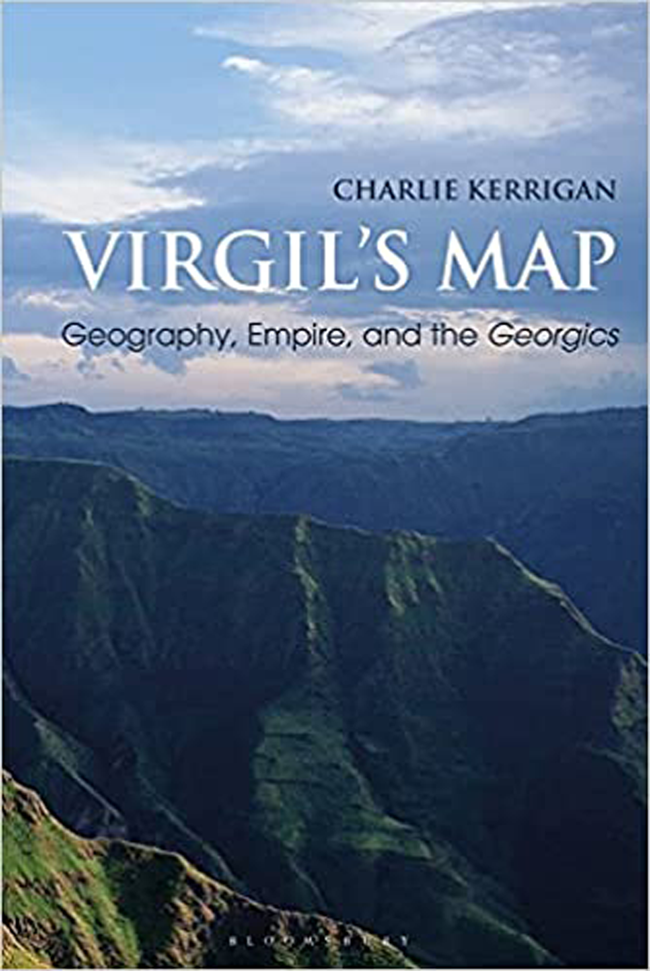
Virgil wrote the Georgics, his second major surviving work, soon after the civil wars of the Late Republic. Dr Charlie Kerrigan seeks a new political meaning in his book, Virgil's Map: Geography, Empire and the Georgics, a reading very obviously in tune with the historical Decolonisation movement. Accordingly, Kerrigan acknowledges his debt to Walter Benjamin, Edward Said and such like. He concludes with an extensive appendix on specific places in the poem and his notes to each chapter, reflecting the author's wide reading.
In Part 1 Kerrigan discusses the history of Roman conquest in the locations described by Virgil in the Georgics, such as Thrace and Iberia. Kerrigan uses an impressive range of ancient historians, from Livy to fragments, to discuss whether these descriptions may indicate Virgil's pride in Roman conquest or hint at the brutality of the occupation. When Kerrigan focuses on precise words, his Decolonising interpretation of the influence from conquered peoples on Rome is very convincing; for example, he draws our attention to the repetition of imperatives ‘to see’, explaining that these words indicate common Roman consciousness about conquered peoples through their products, such as frankincense; these deductions in turn lead him to convincing conclusions about the gradual provincialising of Rome through economic imperialism.
Additionally, Kerrigan uses the first lines of Georgics 1 in tandem with Res Gestae very effectively to argue that Octavian/Augustus portrayed himself as the heir to Alexander the Great, a truly global ruler, and that Romans in Virgil's time saw their civil war in global terms. On the other hand, Kerrigan is less convincing when he says that Virgil used ‘proto-racist’ language about the Indians to justify Roman control of Eastern lands, lacking precise references and critical analysis of the Georgics in this section; he also does not engage with the arguments of scholars such as David Olusoga or Mary Beard, who argue that the Romans did not discriminate on the basis of skin colour.
Building on these points, Kerrigan raises questions about Roman-Italian relations. He argues that the description of pests around Lucania in the poem alludes to possible resistance in the Social War against Roman rule, suppressed by violence and road-building. Unfortunately, he does not analyse the Latin passages in much depth here, leaving the reader possibly baffled about the links between poetic flies and Roman roads. When he focuses on the precise wording of the phrase vacuis…Acerris and links this to the destruction of the city, his argument is much more convincing about a poetic memory of the Social War. Kerrigan also examines the portrayal of the Volsci and Ligurians, in comparison to Livy and Dionysius; he suggests that the similar portrayals of the hardy bellicose people could represent their absorption into Roman history or continuing resistance.
In Part 2, Kerrigan discusses the reception of the Georgics. Firstly, he argues that there has been an ‘aesthetic trend’ in scholarship, so that the political aspects of the Georgics have been downplayed compared to an appreciation of Virgil's rural imagery in the poem. Kerrigan convincingly illustrates this point, particularly with reference to the writings of Joseph Addison. He also refers briefly to the appropriation of a quotation in Georgics 1 by William Pitt in a slave- trade debate, which would be fascinating to discuss further. For, moving onto descriptions of Italy and Africa in the 19th century, Kerrigan shows how the Georgics (most notably the African farmer in Georgics 3) were widely used to depoliticise contemporary perceptions of both Italy and newly-encountered lands and to justify their colonisation as a ‘civilising mission’, just as Romans had ‘civilised’ their conquered territories.
Following these points, Kerrigan discusses references to Virgil's words from Georgics 2, o fortunatas nimium…agricolas! The corollary is that these words were used to portray colonies as too simple for autonomy, thus necessitating British rule. However, he follows J A Froude's description of Australia to J R Seeley's without fully interrogating Froude's use or demonstrating his link to Seeley. Furthermore, his contention that Virgil's words were used to dismiss Irish claims about British imperial misrule lacks an examination of the full context, as he himself admits when he says ‘without entering into a detailed analysis’.
Finally, the author discusses the reception of the Georgics during and immediately after the First World War in Britain. Using reports from the Gloucestershire Chronicle and North Devon Journal, he offers compelling evidence of academics and even middle-class campaigners using the Georgics to advocate more arable farming and self-sufficiency. However, less convincingly, he argues that the Georgics justified the resettlement of British soldiers and portrayed the First World War as an East versus West war, like the Augustan portrayal of Octavian versus Mark Antony.
His only direct evidence is one (Classical scholar) writer, namely Herbert Warren.
As the Georgics are not on the prescribed list for forthcoming exams in A level or IB Latin, this book may not become required reading for a sixth form course in the near future. However, chapter 3 on the Civil War could be useful for high-achieving students studying the ‘Imperial Image’ or ‘Politics of the Late Republic’ modules within OCR A Level Classical Civilisation, were a teacher to preface it with an introduction to the Georgics; furthermore, Kerrigan's argument about the political dimension to Virgil's love of the Italian countryside could be applied and debated when reading Aeneid 7-8 for the ‘World of the Hero’ module on the same course. On the other hand, for school teachers of Classics, especially those very familiar with the Georgics, the book includes some original interpretations of Virgil, encouraging them to review their use of Virgil in the classroom as a source on Roman attitudes to empire.


